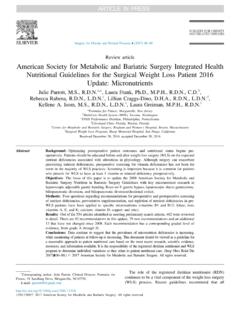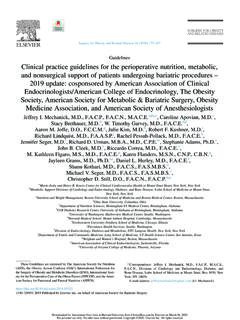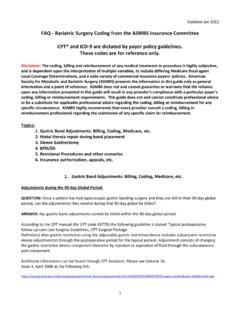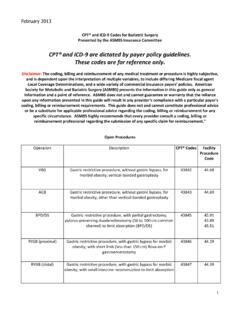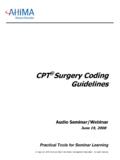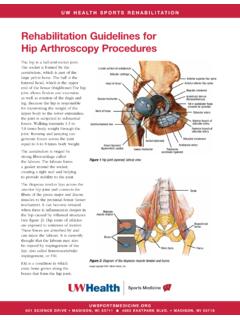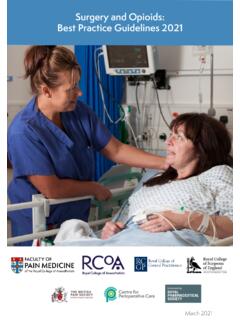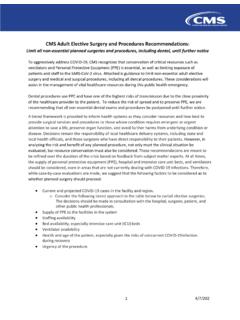Transcription of American Society for Metabolic and Bariatric Surgery ...
1 Surgery for Obesity and Related Diseases](2017) 00 00 Review articleAmerican Society for Metabolic and Bariatric Surgery Integrated HealthNutritional guidelines for the Surgical Weight Loss Patient 2016 Update: MicronutrientsJulie Parrott, , ,*, Laura Frank, , , , ,Rebecca Rabena, , , Lillian Craggs-Dino, , , ,Kellene A. Isom, , , , Laura Greiman, , for Fitness, Morganville, New JerseybMultiCare Health System (MHS), Tacoma, WashingtoncEXOS Performance Dietitian, Philadelphia, PennsylvaniadCleveland Clinic Florida, Weston, FloridaeCenter for Metabolic and Bariatric Surgery , Brigham and Women s Hospital, Boston, MassachusettsfSurgical Weight Loss Program, Sharp Memorial Hospital, San Diego, CaliforniaReceived December 20, 2016; accepted December 20, 2016 AbstractBackground:Optimizing postoperative patient outcomes and nutritional status begins pre-operatively.
2 Patients should be educated before and after weight loss Surgery (WLS) on the expectednutrient deficiencies associated with alterations in physiology. Although Surgery can exacerbatepreexisting nutrient deficiencies, preoperative screening for vitamin deficiencies has not been thenorm in the majority of WLS practices. Screening is important because it is common for patientswho present for WLS to have at least 1 vitamin or mineral deficiency :The focus of this paper is to update the 2008 American Society for Metabolic andBariatric Surgery Nutrition in Bariatric Surgery guidelines with key micronutrient research inlaparoscopic adjustable gastric banding, Roux-en-Y gastric bypass, laparoscopic sleeve gastrectomy,biliopancreatic diversion, and biliopancreatic diversion/duodenal.
3 Four questions regarding recommendations for preoperative and postoperative screeningof nutrient deficiencies, preventative supplementation, and repletion of nutrient deficiencies in pre-WLS patients have been applied to specific micronutrients (vitamins B1 and B12; folate; iron;vitamins A, E, and K; calcium; vitamin D; copper; and zinc).Results:Out of the 554 articles identified as meeting preliminary search criteria, 402 were reviewedin detail. There are 92 recommendations in this update, 79 new recommendations and an additional13 that have not changed since 2008. Each recommendation has a corresponding graded level ofevidence, from grade A through :Data continue to suggest that the prevalence of micronutrient deficiencies is increasing,while monitoring of patients at follow-up is decreasing.
4 This document should be viewed as a guideline fora reasonable approach to patient nutritional care based on the most recent research, scientific evidence,resources, and information is the responsibility of the registered dietitian nutritionist and WLSprogram to determine individual variations as they relate to patient nutritional care. (Surg Obes Relat Dis2017;]:00 00.)r2017 American Society for Metabolic and Bariatric Surgery . All rights role of the registered dietitian nutritionist (RDN)continues to be a vital component of the weight loss Surgery (WLS) process. Recent guidelines recommend that American Society for Metabolic and Bariatric Surgery .
5 All rights reserved.*Corresponding author: Julie Parrott, Clinical Director, Formulas forFitness, 51 Sandburg Drive, Morganville, NJ 1 Pre-WLS Nutrient Screening RecommendationsMicronutrientPre-WLS Nutrient Screening RecommendationRationaleOther ConsiderationsThiamin Routine pre-WLS screening*is recommended forall patients. (Grade C, BEL 3)* Prevalence of thiamin deficiency pre-WLS isreported to be as high as 29%. Thiamin diphosphate, the biologically active formof thiamin, is not found in measurableconcentrations in plasma, and is best determined inwhole blood specimens. Plasma thiaminconcentration reflects recent intake rather than bodystores.
6 Thiamin carried by albumin will bedecreased with concomitant B12 (cobalamin) Routine pre-WLS screening of B12 isrecommended for all patients. (Grade B, BEL 2) Serum MMA is the recommended assay for B12evaluation for symptomatic or asymptomaticpatients and in those with history of B12 deficiencyor preexisting neuropathy. (Grade B, BEL 2) Prevalence of B12 deficiency is reported to be2 18% in patients with obesity and 6 30% inpatients taking proton pump inhibitors. Serum B12 levels alone may not be adequate toidentify B12 deficiency. Elevated MMA levels ( ) maybe a more reliable indicator of B12 status because itindicates a Metabolic change that is highly specificto B12 (Folic Acid) Routine pre-WLS screening is recommended for allpatients.
7 (Grade B, BEL 2) Prevalence of folate deficiency is reported to be ashigh as 54% in patients with obesity. RBC folate and serum homocysteine andnormal MMA levels indicate folate Routine pre-WLS screening is recommended for allpatients. (Grade B, BEL 2) Screening patients for iron status, but not for thepurpose of diagnosing iron deficiency, may includethe use of ferritin levels. (Grade B, BEL 2) A combination of tests (serum iron with serumtransferrin saturation and total iron-bindingcapacity) is recommended for diagnosing irondeficiency. (Grade B, BEL 2) Screening for iron deficiency should includeassessment of clinical signs and symptomscommon to this condition ( , feeling tired andweak, decreased work performance, decreasedimmune function, and glossitis).
8 (Grade B, BEL 2) Prevalence of iron deficiency is reported to be ashigh as 45% in patients with obesity. Ferritin levels should not be used to diagnosedeficiency because iron is an acute-phase reactantand mayfluctuate with age, inflammation, andinfection. Lab tests indicate iron deficiency if irono50 g/dL, ferritino20 g/dL, TIBC4450 D and Calcium Routine pre-WLS screening is recommended for allpatients. (Grade A, BEL 1) Routine pre-WLS screening of calcium status,vitamin D deficiency and insufficiency isparticularly important for pre- and postmenopausalwomen. (Grade D, BEL 4) Prevalence of vitamin D deficiency is reported tobe as high as 90% in patients with obesity.
9 Elevated values of carboxy-terminal telopeptidehave been reported in of patients under50 years of age. Use a combination of laboratory tests: vitamin D,25-OH, serum alkaline phosphatase, PTH, and24-hr urinary calcium in relationship to dietaryintake. Peri- and postmenopausal women may be screenedfor increased bone resorption by using urinary and/or serum type I collagen N-telopeptide levels,which are higher in patients with decreasingestrogen Parrott et al. / Surgery for Obesity and Related Diseases](2017) 00 002 Fat-soluble vitamins (A, E, K) Routine pre-WLS screening is recommended for allpatients.
10 (Grade C, BEL 3) Prevalence of deficiencies pre-WLS is reported tobe vitamin A 14%, vitamin E There are no data on vitamin K deficiencies in pre-WLS patients. Use physical signs and symptoms and labs(Table 5) for:oVit A deficiency: Retinol binding protein and plasma retinoloVit E deficiency: plasma -tocopheroloVit K deficiency: DCPZinc Routine pre-WLS screening of zinc status isrecommended for patients before RYGB or BPD/DS. (Grade D, BEL 3) Zinc assays in pre-WLS patients should beinterpreted in light of the fact that patients withobesity have lower serum zinc levels and lowerconcentrations of zinc in plasma and erythrocytesthan leaner patients.
